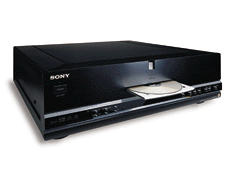|
|


TechnoFILE is copyright and a registered trademark © ® of
Pandemonium Productions.
All rights reserved.
E-mail us Here!
Choosing a DVD Player: Bells, or Whistles?What do you Really Need?
by Jim Bray Since we're supposed to get back into our normal spending habits despite the war, you may have decided to buy a DVD player this fall. If so, what features do you really need, and what's merely icing on the cake? Progressive scan is one of the best features, and it's all the rage right now. Progressive scan DVD players send a picture of "non-interlaced" frames to your TV as opposed to the interlaced "fields" (which are only half a frame each) of typical DVD players and televisions. Color reproduction is remarkable, and there are no scan lines in the picture. The problem is that a progressive scan DVD player is useless on a regular, non digital TV that doesn't have progressive scan video inputs, so unless you're planning to upgrade your TV as well, or want to fight "planned obsolescence" down the road, there's no point in spending the extra dollars now. The same goes for component video output, which is the best way short of progressive scan to watch a DVD. Component video breaks down the picture into its primary components before sending it to the TV, but there's little point if your TV doesn't have component inputs. More and more lower end players offer this feature, however, so it could be worth getting if you plan to upgrade your TV soon. And don't forget: you'll need a video input jack on your TV (even a standard "RCA-type" Video In jack will do) for any DVD player; otherwise you have to patch the DVD player through your VCR and daisy chain the connections that way. It'll work, but it isn't nearly as good. Better than the RCA jack, but not as good as component video, is the S-connector. This is also common on DVD players today, and can be a reasonable compromise if you have the S-input on your TV. The question of whether your DVD player should offer DTS audio as well as Dolby Digital is pretty well moot now. Most players offer both, so don't sweat it excessively. You should know the difference between the two formats, though. In a nutshell, DTS is considered by many to be a "higher end" audio format that supposedly offers better overall sound than Dolby Digital (or, as it used to be called, "AC-3"). If you're buying mainstream equipment for a typical home theater, however, you may never notice the difference. Not only that, but if you're buying a DVD player to plug into a "Dolby Digital-ready" receiver (one that has the separate inputs for the audio channels, but no onboard Dolby Digital decoder), it makes sense to buy a DVD player with its own onboard Digital Surround decoder and audio output jacks. This may limit you to Dolby Digital, but I'm willing to bet you won't care. The only time you might is if you buy a DVD audio disc that has been encoded only in DTS. These are the exceptions rather than the rule, however. Then there's the age old question "Should I have an optical or a coaxial digital audio output?" Fortunately an increasing number of players now offer both, so this also makes the question moot to a certain extent. Unless, of course, you're trying to hook the player into a receiver or preamp that doesn't both, or either, input. Don't forget to check your audio system before heading to the video store! How about a five disc changer versus a single disc player? This is also more of an audio consideration than a video one, unless you like sitting through five movies at a stretch. If you're going to use the DVD player for playing your compact disc library, and you like the convenience of a CD changer, the DVD changer may be your best bet. Don't forget to check out the various players' remote controls and onscreen menus. If all else is equal between players you're auditioning, buy the one that's easiest to learn and use. And remember those menus when you get the player home. The audio output of many DVD's defaults to old fashioned Dolby Pro Logic, rather than the far superior Dolby Digital -- so if you want to enjoy the all-digital signal (assuming your audio equipment has the capability) you'll have to switch to it manually using the setup menu. Jim Bray's technology columns are distributed by the TechnoFILE Syndicate. Copyright Jim Bray.
|
|
|
| Support TechnoFile via Paypal |
| TechnoFILE's
E-letter We're pleased to offer our FREE private, subscription-based private E-mail service. It's the "no brainer" way to keep informed. Our Privacy Policy |